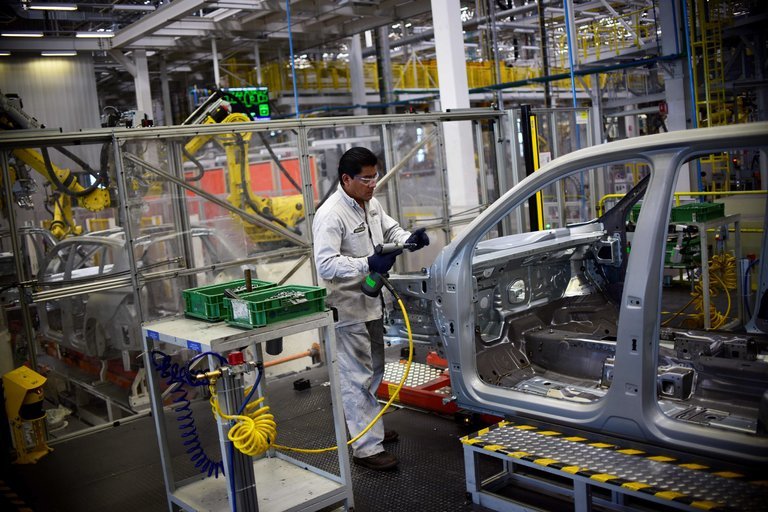Supported by
Politics
White House Tries to Pull Nafta Back From Brink as Deadlines Loom
WASHINGTON — After months of fraught negotiations and stalled talks, the Trump administration is aiming to announce a preliminary deal on the North American Free Trade Agreement this month, moving to resolve one trading conflict as a separate clash with China looms.
A final agreement is far from guaranteed, but the White House is revising some of its more aggressive demands, particularly related to automobiles, which had been a source of tension with Canada and Mexico. A new proposal would require an automobile to contain components made by workers earning a specific wage level to qualify for Nafta’s preferential tariffs. The administration had previously demanded that vehicles contain a large percentage of auto parts produced in the United States.
The new proposal is aimed at stopping United States automakers from shifting production to Mexico in search of cheap labor, according to people familiar with the plan.
President Trump, who earlier this week called Nafta an “embarrassment,” said at an event in West Virginia on Thursday that a deal could be announced shortly. “We’re working very hard on Nafta with Mexico and Canada,” he said. “We’ll have something I think fairly soon.”
Advertisement
Continue reading the main story
Mr. Trump said that his aides were pushing to have something concrete finished before next week’s Summit of the Americas in Peru but that a quick deal was not assured.
Continue reading the main story
“They said, ‘Oh, let’s have Nafta before.’ I said, ‘Don’t rush it. We’ll take it nice and easy, get it done right or we’ll terminate it,” the president said.
The talks, which appeared to be on the brink of collapse just a few months ago, kicked back into gear in recent weeks as political and practical realities prompted a newfound urgency among American negotiators. For a revised Nafta to be approved by the current Republican-controlled congress, the Trump administration would probably have to finalize it before the end of May to allow time for congressional review given the House and Senate calendar.
Other trade tensions helped jump-start the discussions, including the administration’s new steel and aluminum tariffs. The White House temporarily exempted Canada and Mexico from the tariffs through May 1, saying it would make those exemptions permanent if the three nations could agree to a revised Nafta. The administration must now make good on that promise and negotiate a deal that would allow key allies to continue importing metals into the United States. Canada is a top supplier of metal to the United States military.
A quick resolution would also allow negotiators to bypass complications stemming from the upcoming Mexican elections on July 1, which appear likely to usher in a left-leaning president who has sharply criticized Mr. Trump over his broadsides against Mexico. And the White House could promote a revised Nafta as a political win ahead of the congressional midterm elections in November, while giving the president’s top trade advisers room to turn their attention to resolving a potential trade war with China, which has fired back against American trade actions with punitive measures of its own.
White House trade advisers are meeting with their Mexican and Canadian counterparts in Washington this week to try to hammer out areas of consensus on the most difficult issues of the talks. Robert Lighthizer, the United States trade representative, Foreign Minister Chrystia Freeland of Canada and Economy Minister Ildefonso Guajardo of Mexico were expected to kick off trilateral talks on some of the pact’s thorniest issues over dinner in Washington on Thursday night.
Prime Minister Justin Trudeau of Canada struck an optimistic note on Thursday, saying the countries were having a “very productive moment,” a sharp change in tone from previous comments about a Nafta resolution.
“We are in a moment where we are moving forward in a significant way,,” Mr. Trudeau said. “Hopefully there will be some good news coming.”
Advertisement
Continue reading the main story
He is expected to attend the two-day Summit of the Americas in Peru next week, alongside Mr. Trump and President Enrique Peña Nieto of Mexico.
Yet hurdles remain, including how far the United States is willing to go in surrendering many of its negotiating goals, given Mr. Trump’s frequent and vocal criticism of Nafta. Negotiating partners are still waiting to see whether the United States will compromise on the tough requests it has made over the past eight months of negotiations. Many of those demands, including those linked to American auto production, have angered business groups and lawmakers, who say such requirements would actually hurt companies and workers by shifting more manufacturing out of the United States.
A quick resolution would necessitate concessions from the Trump administration, potentially resulting in a deal not significantly different from the one Mr. Trump has denounced as a travesty and embarrassment.
“Unless the United States is quite a bit more flexible, I don’t see how it’s possible to have a quick agreement, even just an agreement in principle,” said Antonio Ortiz-Mena, a senior vice president at the Albright Stonebridge Group and a former Mexican diplomat in the United States.

Some concessions appear to be in the offing. The United States has now backed away from a proposal that would require half of the value of an automobile to be manufactured in the United States to qualify for Nafta’s preferential tariffs. Instead, it is proposing a system that would require a certain proportion of auto parts to be made by workers earning certain wages.
That proposal is likely to be more palatable to Canada and could also encourage Mexico to ultimately pay higher wages. And it could help Mr. Trump court the votes of congressional Democrats, who complain that Mexico’s low wages are the reason companies have relocated auto production from the United States.
Still, the proposal is likely to face opposition from Mexican negotiators, given that their current wage scales are too low to qualify. And some auto executives also criticized the new proposal, saying it would be nearly as difficult for companies to comply with as earlier ideas, and could ultimately push manufacturing out of North America to cheaper areas.
Other key areas of dispute also remain: Negotiators have so far concluded work on only six of the trade agreement’s roughly 30 chapters, and little progress has been made on contentious issues like mechanisms for settling trade disputes or rules for government purchases.
Advertisement
Continue reading the main story
Yet the renewed push to revise Nafta could usher in an agreement that until recently seemed at risk of collapse. Both supporters and critics of the Trump administration have pointed to the trade deal that the United States recently concluded with South Korea at the end of March as a possible precedent. Mr. Trump fiercely criticized that pact, but in the end his administration declared victory after renegotiating fairly modest changes.
Labor unions, which have backed Mr. Trump’s plan to dramatically remake trade policy, were disappointed with that deal, which did not include changes to labor standards, investment rules or content requirements for automotive manufacturing.
“You see what you get if your priority is speed over quality,” said Celeste Drake, trade and globalization policy specialist at the A.F.L.-C.I.O. “A quick deal that’s not a good deal — is that what the administration wants to sell in these next few months? Or is it really looking to take the time it needs to get a good deal?”
Even an agreement in principle would not rule out the possibility of months or years of wrangling over an eventual deal. Patrick Leblond, senior fellow at the Center for International Governance Innovation, noted that Canada and Europe signed an agreement in principle for a trade pact in the fall of 2013, but that the final deal did not come into effect until September 2017, after almost being derailed.
“As trade negotiators repeatedly point out, nothing is agreed until everything is agreed,” Mr. Leblond said.
Follow Ana Swanson on Twitter: @AnaSwanson.
Get politics and Washington news updates via Facebook, Twitter and the Morning Briefing newsletter.
Continue reading the main story Read the Original Article




























